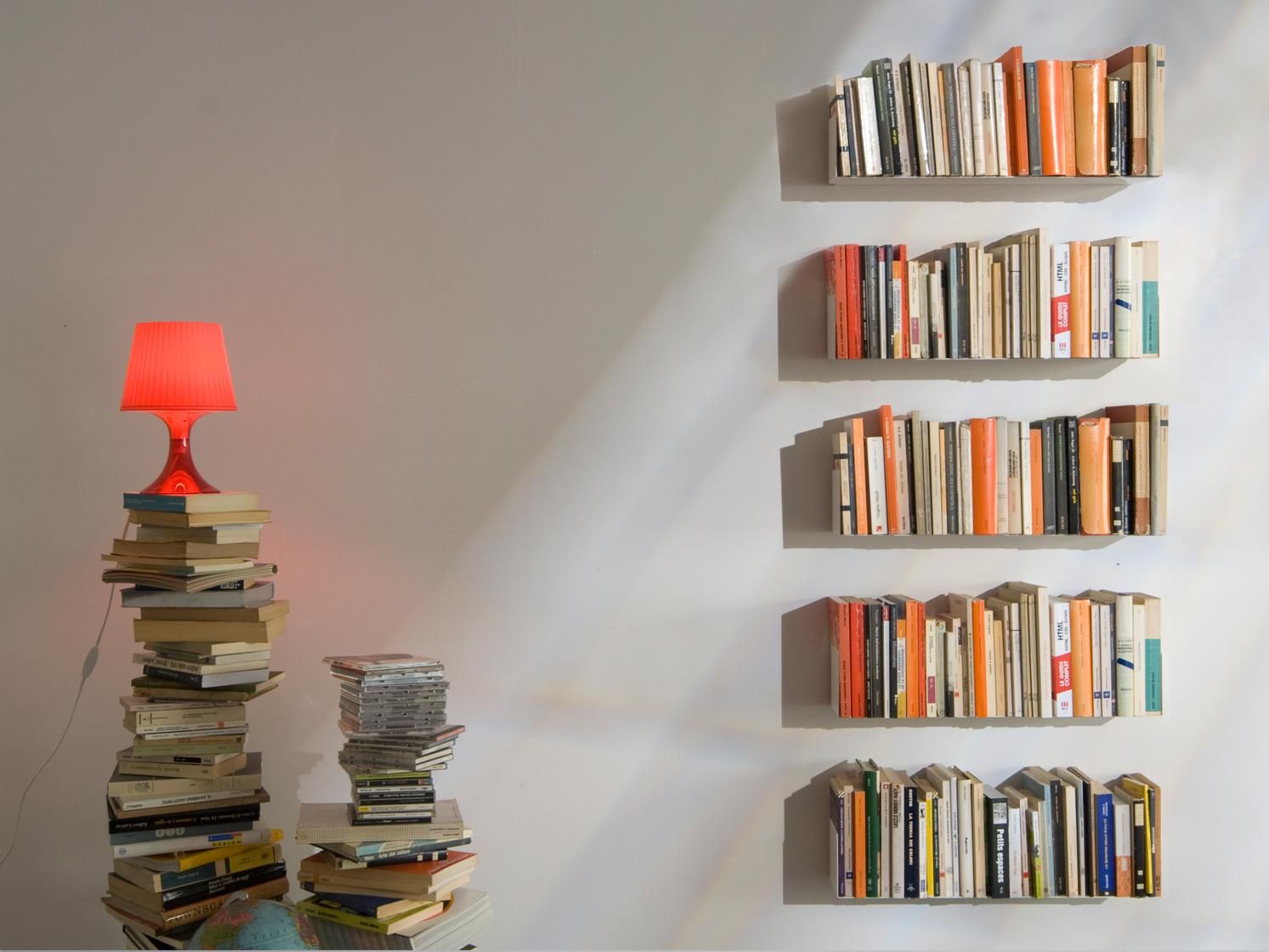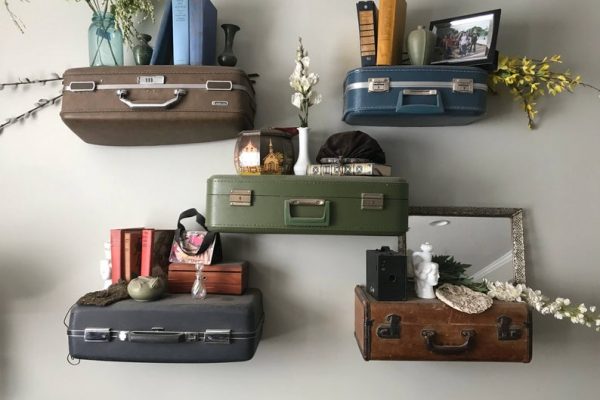Home>Interior Design>Organizing A Bookshelf: 15 Ways To Keep On Top Of Your Tomes


Interior Design
Organizing A Bookshelf: 15 Ways To Keep On Top Of Your Tomes
Modified: February 23, 2024
Discover 15 brilliant techniques for interior design enthusiasts to effortlessly organize their bookshelves and maintain impeccable style.
(Many of the links in this article redirect to a specific reviewed product. Your purchase of these products through affiliate links helps to generate commission for Storables.com, at no extra cost. Learn more)
Introduction
Organizing your bookshelf not only enhances the visual appeal of your home but also makes it easier to find and access your favorite books. Whether you have a small collection or a vast library, having a system in place will allow you to keep on top of your tomes and maintain order in your reading space.
In this article, we will explore fifteen creative ways to organize your bookshelf. From categorizing by genre to sorting by author’s last name, these tips and techniques will help you create a well-organized and aesthetically pleasing book display. So, let’s dive in and discover how to transform your bookshelf into a functional and stylish focal point in your home.
Key Takeaways:
- Transform your bookshelf into a functional and stylish focal point by organizing your collection with creative techniques such as categorizing by genre, sorting by author’s last name, and arranging by publication date.
- Showcase your love for literature and express your personal style by incorporating stacking and layering techniques, organizing by cover design, and grouping books by format. Embrace the joy of curating your bookshelf and let it evolve along with your reading journey.
Categorizing by Genre
Categorizing your books by genre is a classic and effective way to organize your bookshelf. Start by gathering all your books and sorting them into different genres such as mystery, romance, science fiction, fantasy, and non-fiction. This not only makes it easier to locate books based on your mood or interest but also creates a cohesive and visually appealing display.
To enhance the organization further, you can consider using bookends or labeling each section with decorative tags or stickers. This way, you can quickly find and return books to their designated genre section, keeping your bookshelf tidy at all times.
Additionally, categorizing by genre allows you to create mini-collections within your bookshelf. You can showcase your favorite detective novels, epic fantasy series, or self-help books separately, making it easier for you to navigate through your collection based on your reading preferences.
Another advantage of categorizing by genre is that it creates opportunities for thematic displays. You can decorate the genre sections with related props or artwork to enhance the overall ambiance of your bookshelf. For instance, if you have a section dedicated to fantasy novels, you can add small dragon figurines or fairy lights to create a magical atmosphere.
As you arrange your books by genre, you may come across books that fit into multiple categories. In this case, determine which genre the book primarily belongs to or place it in a separate section for miscellaneous books.
Categorizing by genre not only organizes your books logically but also adds a touch of sophistication to your bookshelf. It allows you to showcase your diverse literary taste and makes it a breeze to locate your next captivating read.
Sorting by Author’s Last Name
Sorting your books by the author’s last name is a simple yet effective method to organize your bookshelf. This method ensures that books by the same author are grouped together, making it convenient to find and access specific titles.
Start by arranging your books in alphabetical order based on the author’s last name. You can either do this manually or use a bookshelf organization app or software to help you with the sorting process. By following this method, you can easily locate books by your favorite authors or find other works by an author you recently enjoyed.
When applying this method, it’s important to consider authors who use pseudonyms or pen names. In such cases, sort the books based on the pseudonym or pen name rather than the actual last name. This ensures that all books by the same author, regardless of the name they are published under, are grouped together.
If you have multiple books by the same author, you can further organize them in chronological order by publication date. This way, you can easily track an author’s writing progression and explore their work in the order it was released.
This sorting method is not only practical but also visually appealing. It creates a clean and cohesive look on your bookshelf, making it easy for you and others to navigate through your collection. Consider using bookends or decorative dividers to separate sections for each author’s last name, adding a touch of style to your organized book display.
Sorting by author’s last name is particularly useful if you frequently recommend books or lend them to friends. In conversations, you can mention the author’s name with ease, making it simpler for others to find the book in their own collection or at a library.
By sorting your books by the author’s last name, you not only create a well-organized bookshelf but also gain a better understanding of your literary interests and preferences. So, arrange your books alphabetically and let the joy of finding your next beloved author begin!
Organizing by Book Size
Organizing your books by size is an aesthetic and functional way to create an eye-catching display on your bookshelf. This method adds a visual element to your organization system and can create a harmonious and balanced arrangement.
Start by collecting your books and categorize them based on their height. You can group them into small, medium, and large sizes or any other size variations that you prefer. Once you have categorized your books, arrange them on the shelf from tallest to shortest or vice versa.
Organizing your books by size creates a visually appealing display as the books stack neatly and create a sense of symmetry. This can be especially pleasing if you have open shelving or glass doors on your bookcase. The varying heights of the books add depth and texture to your bookshelf, creating an interesting visual focal point.
In addition to the aesthetic appeal, organizing by book size can also be practical. It allows you to optimize the use of space on your bookshelf, especially if you have limited room. By organizing the books based on size, you can fit them together more efficiently and utilize all available space.
Furthermore, organizing by book size can also help protect your books from damage. When books are stacked together based on their size, they are less likely to lean or fall over, reducing the risk of creased pages or damaged covers. This method is particularly useful for books with delicate spines or larger coffee table books.
To enhance the visual impact, you can incorporate decorative bookends or bookshelf accessories that complement your book sizes. These can include bookends in shapes or colors that match your décor, or small decorative objects placed strategically between the books to create visual interest.
Organizing your books by size not only adds a stylish touch to your bookshelf, but also adds a sense of order and balance to your space. So, gather your books, start arranging them by size, and transform your bookshelf into an organized and visually pleasing display.
Arranging by Publication Date
Arranging your books by publication date is a fascinating way to organize your bookshelf and gain insights into the historical context of your collection. By organizing your books in chronological order, you can appreciate the progression of literature and observe the evolution of different genres and writing styles.
To begin, gather your books and conduct research to obtain accurate publication dates for each one. This information can usually be found on the copyright page or through online sources. Once you have the publication dates, arrange your books starting from the oldest to the most recent.
Organizing your books by publication date not only provides a historical perspective but also creates an interesting visual narrative. As you scan your bookshelf, you can observe how literature has evolved over time, from classics to contemporary novels.
This method is particularly enjoyable for bibliophiles who appreciate the historical context and development of literature. It allows you to discover authors and works that were influential in different time periods and explore the literary trends of each era.
Arranging your books by publication date can also be combined with other organization methods. For instance, you can categorize books by genre within each time period, creating subsections that showcase the diversity of literature within specific eras. This combination of organization methods adds depth and interest to your bookshelf.
In addition to its aesthetic appeal, organizing by publication date can be useful for scholars or researchers who want to study the progression of a specific author’s work or a particular genre. It allows you to easily locate and reference books that were published in a specific time period, enhancing your understanding of literary history.
To complement the organization method, consider placing relevant historical artifacts or decorations alongside the books to add a visually appealing touch. This could include vintage bookplates, bookmarks, or small collectibles that evoke the era in which the books were published.
Arranging your books by publication date not only creates an organized bookshelf but also provides a journey through literary history. So, dive into the fascinating world of literature, gather your books, and arrange them in chronological order to discover the rich tapestry of literary works.
Grouping by Series
If you’re a fan of book series, organizing your bookshelf by series is a fantastic way to showcase your devotion to a particular set of books and keep them together for easy access.
To begin organizing by series, gather all the books belonging to a specific series and place them together on the shelf. Start with the first book in the series and arrange the rest in chronological order according to their publication or reading order.
Grouping books by series allows you to appreciate the continuity of characters, storylines, and themes across multiple books. It also makes it effortless to find the next installment when you’re ready to dive back into the series.
Consider adding decorative elements or bookends to separate different series on your bookshelf. This not only adds visual appeal but also helps to maintain the integrity of each series and prevents books from getting mixed up.
If you have multiple book series, you can create dedicated sections on your bookshelf for each one. For example, you could reserve a specific shelf or area for fantasy series and another for mystery series. This creates a visually organized and cohesive display.
Organizing by series also allows you to easily identify gaps in your collection. If you’re missing a book or two from a series, seeing the empty spaces on your bookshelf serves as a reminder to complete the set.
In addition to being practical, organizing by series also sparks conversation and makes it easier to recommend books to fellow readers. You can easily spot books in a specific series and share your enthusiasm for a well-loved storyline.
Lastly, grouping by series creates a satisfying visual impact on your bookshelf. It creates a sense of order and cohesion as the books in the series are displayed together, showcasing your commitment to the stories and authors you adore.
Whether it’s a beloved fantasy saga or a captivating mystery series, organizing your bookshelf by series is a wonderful way to keep your favorite stories intact and showcase your passion for a particular literary world. So, gather your series, arrange them in order, and let your bookshelf become a haven for epic adventures.
Separating Fiction and Non-Fiction
One of the most straightforward and effective ways to organize your bookshelf is by separating your fiction and non-fiction books. This method allows you to easily distinguish between different types of literature and access the specific genre you’re in the mood for.
To begin, gather all your books and divide them into two main categories: fiction and non-fiction. Fiction books encompass novels, short story collections, and poetry, while non-fiction includes subjects such as history, biographies, self-help, and reference books.
Once you have categorized your books, arrange them separately on your bookshelf, with fiction books displayed in one section and non-fiction in another. You can further subcategorize within each section if you have a vast collection. For example, within fiction, you can separate genres like romance, science fiction, and mystery.
Organizing by fiction and non-fiction allows you to easily determine the type of book you’re searching for and facilitates quick browsing. Whether you’re looking for a gripping novel for a cozy evening or a factual book to expand your knowledge, this method helps you navigate your collection effortlessly.
Separating fiction and non-fiction also creates a clean and organized look on your bookshelf. It offers a visual contrast, with fiction books often showcasing vibrant covers and non-fiction books typically presenting more traditional and informative designs.
Another benefit of this method is that it makes it easier to spot gaps in your collection. If you notice a particular genre is lacking in either fiction or non-fiction, it serves as a reminder to explore new authors or subjects to broaden your reading horizons.
In addition to the practicality, separating fiction and non-fiction also allows you to showcase your diverse reading interests and share recommendations more effectively. You can easily direct someone to the fiction or non-fiction section based on their preferences, making it simple for others to browse through your collection.
By organizing your bookshelf with a clear division between fiction and non-fiction, you create a well-structured and visually appealing display. So, gather your books, separate them into their respective categories, and enjoy the ease of finding the perfect read for every mood.
Organizing by Language
If you have a collection of books in multiple languages, organizing your bookshelf by language can be a practical and visually interesting approach. This method allows you to easily locate books in specific languages and appreciate the linguistic diversity of your collection.
To get started, gather your books and separate them based on the language in which they are written. You can create dedicated sections for each language or arrange them in alphabetical order based on the language’s name.
Organizing by language not only makes it easier to find books written in a specific language but also offers a glimpse into different cultures and literary traditions. It provides a visual representation of the various languages represented in your collection and adds a worldly touch to your bookshelf.
In addition to separating books by language, you can further categorize them within each language based on genre or author. This subcategorization allows for more specific organization and facilitates targeted browsing within a particular language section of your bookshelf.
Organizing by language can be particularly useful if you’re multilingual or have an interest in studying different languages. It provides a quick reference for finding books to practice your language skills or explore literature in a language you’re learning.
This method also allows you to showcase your love for international literature and presents an opportunity to recommend books from various languages to friends or guests.
Consider adding decorative elements such as small flags or labels with the names of languages to enhance the visual appeal and make it easier to identify each language section on your bookshelf.
Organizing your bookshelf by language not only brings order to your collection but also celebrates the richness of global literature. So, arrange your books by language and let your bookshelf become a testament to the power of words in different tongues.
Alphabetizing by Title
If you’re someone who loves the simplicity and ease of finding books alphabetically, organizing your bookshelf by title can be a straightforward and effective method. Alphabetizing your books allows for quick access to specific titles and creates a clean and organized look on your bookshelf.
To begin, gather all your books and arrange them in alphabetical order based on the title. Start with the first word of the title and continue alphabetically. If the title begins with “The,” “A,” or “An,” ignore those words and alphabetize by the next word.
When alphabetizing, you can choose to ignore any articles, prepositions, or conjunctions in the title, focusing only on significant words. This helps maintain consistency, especially when titles begin with common words like “The” or “A.”
Organizing by title allows you to easily locate specific books, whether you’re looking for a particular novel or referencing a non-fiction book. It eliminates the need to remember the author’s name or recall other details about the book since you can simply scan the titles to find what you’re looking for.
This method works well if you have a diverse collection spanning different genres and authors. It treats each title as equal in importance, making it a fair and unbiased way of organizing your books.
To enhance the visual appeal, consider using bookends or decorative dividers to separate sections of the alphabet on your bookshelf. This not only adds a stylish touch but also helps to maintain the organization and prevent books from getting jumbled together.
Alphabetizing by title is a practical and timeless method of organizing your bookshelf. It creates a logical and systematic arrangement and ensures that every book has its rightful place. So, gather your books, alphabetize them by title, and enjoy the simplicity and ease of locating your favorite reads.
Use bookends to keep books upright and organized by category or genre. This will make it easier to find and access the books you want to read.
Sorting by Color
If you’re looking to infuse a visually striking and artistic element into your bookshelf organization, sorting your books by color can be a unique and dazzling approach. This method transforms your collection into a vibrant spectrum that adds a pop of color to your space.
To begin, arrange your books based on their spine colors, starting from one end of the color spectrum and moving to the other. You can follow the rainbow sequence, beginning with red and moving through orange, yellow, green, blue, indigo, and violet. Alternatively, you can create your own color arrangements to suit your aesthetic preferences.
Sorting books by color creates a visually captivating display that can become an eye-catching focal point in any room. It adds a sense of whimsy and creativity to your bookshelf, showcasing your books as both sources of knowledge and works of art.
Additionally, organizing by color makes it easy to find and select books based on their visual appeal. If you’re in the mood for an aesthetically pleasing display, you can quickly locate books with vibrant or contrasting colors to create a stunning arrangement.
This organizing method also allows for interesting and playful combinations. You can experiment with color gradients, creating a smooth transition from one shade to the next. Using decorative objects such as flowers, figurines, or bookends in coordinating colors can further enhance the visual impact.
It’s important to note that sorting by color may not be the most practical method if you have a large collection or need frequent access to specific books. In such cases, you may want to combine this method with other organizational methods, such as grouping books by genre or author within each color section.
Sorting by color offers a delightful and unconventional approach to organizing your bookshelf. It transforms your collection into a stunning visual display while expressing your artistic flair. So, gather your books, let your imagination run wild, and create a rainbow of literature on your bookshelf.
Arranging by Ownership (Borrowed vs. Owned)
If you have a combination of books you personally own and books you have borrowed from others, organizing your bookshelf by ownership can be a practical and considerate approach. This method allows you to keep track of borrowed books and ensures they are returned to their rightful owners in a timely manner.
To start organizing by ownership, distinguish between books you own and books you have borrowed. Place the borrowed books in a separate section or designate a specific shelf or area for them on your bookshelf.
Arranging your books by ownership ensures that borrowed books are separate and easily identifiable. This way, you can prioritize returning them to their owners when the borrowing period is over, preventing any confusion or accidental retentions.
Within the borrowed books section, consider labeling each book with the name of the owner or a small placeholder to indicate who the book belongs to. This helps you keep track of borrowed books and reminds you of their return deadline.
Organizing by ownership not only aids in book management but also promotes good borrowing etiquette. It demonstrates respect for other people’s property and helps you maintain positive relationships with book lending friends or family members.
In addition to borrowed books, your owned books can be organized using other methods such as genre, author, or title, depending on your personal preferences. This allows you to easily find and access your own collection without confusion.
Sorting by ownership also serves as a visual reminder of the books you have borrowed and can prompt you to return them promptly. As you see the separate section dedicated to borrowed books, it acts as a gentle nudge to fulfill your borrowing commitments.
By organizing your bookshelf by ownership, you establish clear distinctions between books you own and those you have borrowed. This ensures proper care and return of borrowed books and allows you to enjoy your personal collection without any mix-ups. So, gather your books, arrange them by ownership, and uphold borrowing etiquette while showcasing your own literary treasures.
Displaying by Cover Design
If you have a collection of books with visually stunning cover designs, organizing your bookshelf by cover design can create a captivating and visually appealing arrangement. This method showcases the artistic elements of each book and turns your bookshelf into a work of art itself.
To begin, gather your books and pay attention to the cover designs. Look for books with beautiful artwork, striking typography, or unique designs that catch your eye. Group these books together and arrange them in a way that highlights their cover designs.
When arranging by cover design, you can choose to organize them based on color schemes, patterns, themes, or even by the book’s overall aesthetic appeal. Creating visually pleasing arrangements adds an element of creativity and personal expression to your bookshelf.
Consider incorporating other decorative items, such as plants, small sculptures, or bookends, to complement and enhance the visual impact of the cover designs. You can also experiment with arranging books in different orientations, such as stacking some horizontally or placing them in alternating patterns, to create an interesting display.
Organizing by cover design allows you to appreciate the artistic elements of books and creates an aesthetically pleasing display. It can serve as a conversation starter, as visitors or friends will undoubtedly be drawn to the visually striking arrangement and may inquire about specific books or cover designs.
Remember that organizing by cover design doesn’t necessarily prioritize the content of the books themselves. If you also want to prioritize easy access to specific genres or authors, consider combining this method with other organizational approaches, such as arranging books by genre within each cover design group.
By organizing your bookshelf by cover design, you transform your collection into a visually captivating display and showcase the beauty of book cover art. So, gather your books with stunning covers, curate an arrangement that delights your eyes, and let your bookshelf become a gallery of visual masterpieces.
Organizing by Topic or Theme
Organizing your bookshelf by topic or theme is an effective way to create a focused and cohesive arrangement. This method allows you to group books together based on similar subjects, making it easier to navigate your collection and find books that align with your interests.
To begin organizing by topic or theme, gather your books and identify common threads or subjects among them. This could be broad topics like history, science, or philosophy, or more specific themes like travel, self-help, or cooking. Sort your books into different categories based on these topics or themes.
Once you have categorized your books, arrange them on your bookshelf in a way that visually represents each topic or theme. You can create sections or shelves dedicated to specific subjects, making it easy to locate books related to a particular interest.
Organizing by topic allows for easy exploration of specific subjects. If you’re in the mood for books on a particular topic, you can quickly browse the relevant section and find books that pique your curiosity.
This method also helps you identify any gaps in your collection and serves as a reminder to diversify your reading choices. By visually seeing the distribution of topics on your bookshelf, you can easily determine areas where you may want to expand your knowledge or explore new genres.
Consider using labels, stickers, or dividers to clearly denote different topics or themes on your bookshelf. This enhances the organization and allows for easy identification, especially if you have a large collection or are sharing your books with others.
Organizing by topic or theme also offers an opportunity for further personalization and expression. You can incorporate decorative elements or artwork related to each subject, making your bookshelf not only organized but also visually engaging and reflective of your interests.
By organizing your bookshelf by topic or theme, you create a curated collection that aligns with your intellectual curiosity and passions. So, gather your books, identify common subjects, and let your bookshelf become a reflection of your diverse interests and areas of expertise.
Grouping by Format (Hardcover vs. Paperback)
If you have a mix of hardcover and paperback books in your collection, organizing your bookshelf by format can be a practical and visually appealing approach. This method allows you to group books together based on their physical characteristics, making it easier to locate books of a specific format and creating a cohesive display.
To begin, separate your books into two main categories: hardcover and paperback. You can do this by carefully examining the binding of each book or checking the book’s copyright information.
Once you have categorized your books, arrange them on separate sections or shelves of your bookshelf, with hardcover books in one area and paperback books in another.
Grouping by format allows for easy identification and access to books based on your preferences. If you have a preference for one format over the other, this method makes it convenient to browse and select books of your preferred style.
Another advantage of grouping by format is that it helps protect the books. Hardcover books are generally more durable and resistant to wear and tear compared to paperbacks. Keeping them separate can help maintain their condition by minimizing the risk of damage.
Additionally, organizing by format can also create a visually pleasing arrangement on your bookshelf. The contrast between hardcover and paperback books adds a dynamic and aesthetic appeal to the overall display.
Consider adding decorative elements, such as bookends or labels, to further enhance the visual organization of your bookshelf by format. This not only adds a touch of style but also helps maintain the separation of different formats.
Grouping by format also offers an opportunity for efficient space utilization on your bookshelf. Since hardcover books tend to be larger and thicker, separating them from paperbacks allows for better stacking and arrangement, maximizing the use of available space.
By organizing your bookshelf by format, you create an orderly and visually appealing display that makes it easier to find books based on your preferences. So, gather your collection, sort them by format, and let your bookshelf showcase the diverse charm of both hardcover and paperback books.
Sorting by Personal Rating or Importance
Sorting your bookshelf by personal rating or importance allows you to prioritize and showcase the books that have had a significant impact on you or hold a special place in your heart. This method not only helps you easily locate and revisit your favorite reads but also serves as a reflection of your reading preferences and journey.
To begin organizing by rating or importance, consider creating a rating system or scale that best suits your preferences. You can use a numerical system, star ratings, or even categories like “must-read,” “highly recommend,” or “personal favorite.”
Assign ratings to each book based on your personal evaluation of them. This can be subjective and based on criteria such as the book’s impact on you, its literary merit, emotional connection, or pure enjoyment.
Once you have rated your books, arrange them on your bookshelf in descending order, from the highest-rated or most important books to the lowest-rated. This way, the books that have had the greatest influence or hold the highest significance to you are prominently displayed.
Sorting by personal rating or importance allows for easy access to books that have left a lasting impression or hold sentimental value. It provides a curated selection of your favorite reads that you can readily recommend to others or revisit whenever you’re in need of literary comfort.
This method also offers an opportunity for self-reflection and growth as a reader. As you assess your books and determine their importance, you can gain insights into your evolving taste, interests, and literary journey over time.
Consider adding small personalized notes or bookmarks to the highly-rated or important books, explaining why they hold such significance for you. This personal touch adds depth and enhances the emotional connection you have with the books.
Sorting by personal rating or importance is a meaningful and introspective way to organize your bookshelf. It allows you to curate a collection that reflects your literary experiences and showcases the books that have shaped your reading journey. So, gather your books, rate them, and let your bookshelf become a tribute to the profound impact of literature.
Stacking and Layering Techniques
Stacking and layering techniques can add depth, visual interest, and a touch of creativity to your bookshelf arrangement. By incorporating these techniques, you can create a visually captivating display that goes beyond the traditional straight line of books on a shelf.
Stacking books horizontally can break up the monotony of vertical spines and add a sense of dynamism to your bookshelf. You can create small stacks of books with similar themes or sizes, placing them strategically throughout your bookshelf. This technique not only adds visual interest but also provides an opportunity to showcase book covers or titles that might have been hidden in a traditional arrangement.
Another technique is layering books, where you place smaller or differently sized books in front of larger ones, partially covering the spines. This method creates a sense of depth and adds a three-dimensional aspect to your bookshelf. Experiment with different combinations of shapes and sizes to create visually appealing arrangements.
When stacking or layering books, it’s essential to ensure stability and avoid causing damage to your books. Use bookends or other supportive objects to keep the stacks secure and prevent books from falling. Additionally, be mindful of the weight of the books to avoid placing too many in one stack, which could place unnecessary strain on the ones at the bottom.
Consider incorporating decorative objects such as small sculptures, vases, or trinkets between book stacks or on top of layered books. This adds a personal touch and further enhances the visual appeal of your bookshelf display.
Stacking and layering techniques offer an opportunity for artistic expression and personalization. You can experiment with different arrangements and configurations to find the one that best suits your style and complements your home decor.
It’s important to note that while stacking and layering can create a visually stunning display, it may make it slightly more challenging to locate books or access them individually. However, if you are more focused on the aesthetic appeal and are familiar with the content of your books, this should not pose a significant issue.
By incorporating stacking and layering techniques into your bookshelf organization, you can create a unique and visually captivating arrangement. So, gather your books, unleash your creativity, and let your bookshelf become a masterpiece of stacked and layered literary beauty.
Conclusion
Organizing your bookshelf is not just about tidiness, it’s an opportunity to showcase your love for literature, express your personal style, and make your collection easily accessible. Whether you’re a passionate bibliophile or simply looking to declutter, these fifteen organizing techniques offer a range of creative options to transform your bookshelf into a functional and visually appealing space.
From categorizing by genre and sorting by author’s last name to arranging by publication date and grouping by series, there are numerous approaches to suit your preferences and needs. Whether you prefer a methodical and structured arrangement or a more visually dynamic display, there’s a technique that will make your bookshelf organization a delight.
Remember to strike a balance between visual appeal and practicality. While it’s important to express your personal style and creativity, it’s equally crucial to ensure that you can easily find and access the books you’re looking for. Consider combining different methods to achieve both an aesthetically pleasing arrangement and functional organization.
As you embark on the journey of organizing your bookshelf, take the opportunity to reflect on your reading journey, discover hidden gems within your collection, and explore new genres or authors. Your bookshelf is a reflection of your literary interests and can serve as a conversation starter, a source of inspiration, and a sanctuary for your favorite stories.
Lastly, organizing your bookshelf is a continuous process. As you acquire new books or your tastes evolve, you may need to revisit and adjust your organization techniques. Embrace the joy of curating your bookshelf and allow it to grow and evolve along with your reading journey.
So, gather your books, unleash your creativity, and embark on the task of organizing your bookshelf. Let it become a space that not only reflects your love for literature but also inspires you and invites others into the enchanting world of books.
Frequently Asked Questions about Organizing A Bookshelf: 15 Ways To Keep On Top Of Your Tomes
Was this page helpful?
At Storables.com, we guarantee accurate and reliable information. Our content, validated by Expert Board Contributors, is crafted following stringent Editorial Policies. We're committed to providing you with well-researched, expert-backed insights for all your informational needs.













0 thoughts on “Organizing A Bookshelf: 15 Ways To Keep On Top Of Your Tomes”